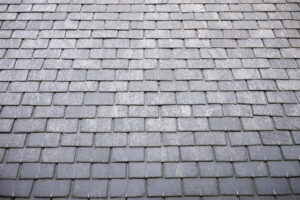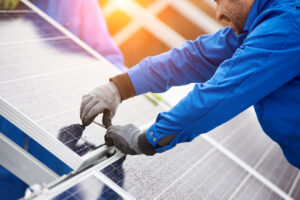Best Roofing Materials for Hot Climates: Keep Your Home Cool and Comfortable

*Updated August 6th, 2025
Are you tired of sweltering in your home during the hot summer months? Your roof might be the culprit. In hot and sunny regions, the roof is exposed to intense heat and UV radiation, which can take a toll on the material’s durability and energy efficiency.
If you live in a hot climate, selecting the right roofing material can not only protect your home but also help maintain a comfortable indoor temperature and potentially lower your energy bills. Let’s explore the eight best roofing materials for hot climates, their unique advantages, and what makes them suitable for these demanding conditions.
Best Roofing Materials for Hot Climates

1. Asphalt Shingles: An Affordable and Versatile Option
Asphalt shingles are a popular choice for hot climates due to their affordability and easy installation. These shingles are made from a fiberglass or organic mat coated with asphalt and mineral granules. While they may not be the most energy-efficient option, asphalt shingles are available in a variety of colors, including cool roof options that reflect more sunlight and help reduce heat absorption.
- Cost-effective
- Easy to install and maintain
- Available in various colors and styles

2. Metal Roofing: Durable and Energy-Efficient
Metal roofing is an excellent choice for hot climates due to its high reflectivity and durability. Materials like steel, aluminum, and copper are commonly used for metal roofs. These roofs are designed to reflect a significant amount of solar radiation, keeping your home cooler and reducing the need for air conditioning. Metal roofs are also fire-resistant, low-maintenance, and can last for decades with proper installation and care.
- High reflectivity and emissivity
- Long-lasting and low-maintenance
- Fire-resistant and eco-friendly

3. Slate Tiles: Timeless Beauty and Durability
Slate tiles are a premium roofing material known for their longevity and natural beauty. These tiles are quarried from sedimentary rock and are highly resistant to heat, fire, and moisture. Slate roofs are naturally cool due to their high thermal mass, which helps regulate indoor temperatures. However, they can be expensive and require professional installation due to their weight and fragility.
- Long-lasting and durable
- Naturally cool and heat-resistant
- Aesthetically appealing and timeless

4. Clay Tiles: Classic Charm and Thermal Efficiency
Clay tiles have been used for centuries in hot climates due to their excellent thermal properties and durability. These tiles are made from natural clay and fired in a kiln, creating a porous and lightweight material that allows for air circulation and heat dissipation. Clay tiles come in a variety of styles and colors, adding a distinctive aesthetic to your home while providing excellent protection against the elements.
- Excellent thermal properties
- Durable and long-lasting
- Variety of styles and colors

5. Concrete Tiles: Durability and Thermal Mass
Concrete tiles are a popular choice in hot climates due to their thermal mass and durability. These tiles are made from a mixture of cement, sand, and water, and can be shaped and colored to mimic the appearance of other roofing materials like clay or slate. Concrete tiles are fire-resistant, low-maintenance, and can help keep your home cooler by absorbing and slowly releasing heat.
- High thermal mass
- Fire-resistant and low-maintenance
- Versatile in style and appearance

6. Solar Roofing: Energy-Efficient and Sustainable
Solar roofing is an innovative and energy-efficient option for hot climates. These systems integrate photovoltaic (PV) panels or solar shingles directly into the roof, allowing you to generate clean electricity while protecting your home from the sun’s heat. Solar roofs not only reduce your energy bills but also contribute to a more sustainable future by harnessing renewable energy.
- Generates clean electricity
- Reduces energy bills
- Contributes to a sustainable future

7. Green Roof: Insulation and Environmental Benefits
Green roofs, also known as living roofs, are becoming increasingly popular in hot climates due to their ability to provide insulation and improve energy efficiency. These roofs are covered with a layer of vegetation, typically drought-resistant plants and a growing medium. Green roofs help reduce heat absorption, regulate indoor temperatures, and provide additional benefits like stormwater management and improved air quality.
- Provides insulation and energy efficiency
- Reduces heat absorption
- Offers environmental benefits

8. Membrane Roofing: Reflectivity and Durability
Membrane roofing, such as TPO (Thermoplastic Polyolefin) or EPDM (Ethylene Propylene Diene Monomer) membranes, is a popular choice for flat or low-slope roofs in hot climates. These roofing systems are designed to reflect a significant amount of solar radiation, helping to keep your home cooler. Membrane roofs are also durable, UV-resistant, and can be installed with various insulation layers for improved energy efficiency.
- High reflectivity
- Durable and UV-resistant
- Can be installed with insulation layers
What Makes a Roofing Material Suitable for Hot Climates?
Several factors contribute to the suitability of a roofing material for hot climates:
1. Reflectivity and Emissivity
The ability of roofing material to reflect and emit heat is crucial in hot climates. Materials with high reflectivity and high emissivity can reduce heat absorption and help keep your home cooler. This is often measured by the material’s Solar Reflectance Index (SRI) or Cool Roof Rating (CR), with higher values indicating better performance.
2. Thermal Mass
Roofing materials with high thermal mass, such as concrete, clay, and slate tiles, can absorb and slowly release heat, helping to regulate indoor temperatures and reducing the need for cooling during peak hours.
3. Durability and Low Maintenance
Hot climates can be harsh on roofing materials, subjecting them to intense sunlight, high temperatures, and occasional severe weather events. Materials that are durable, low-maintenance, and resistant to cracking, fading, or warping are ideal for these conditions.
4. Energy Efficiency
In hot climates, energy-efficient roofing materials can significantly reduce your cooling costs and overall energy consumption. Materials that reflect solar radiation, provide insulation, or generate renewable energy (like solar roofing) can contribute to a more sustainable and cost-effective home.
FAQs About the Best Roofing Materials for Hot Climates
Q: What is the most energy-efficient roofing material for hot climates?
A: Solar roofing and metal roofing are among the most energy-efficient options for hot climates. Solar roofing generates renewable energy, while metal roofs have high reflectivity and emissivity, helping to reduce heat absorption and keep your home cooler.
Q: Are green roofs a good choice for hot climates?
A: Yes, green roofs can be an excellent choice for hot climates. The vegetative layer helps provide insulation and regulate indoor temperatures, reducing the need for cooling. However, green roofs require proper maintenance and may not be suitable for all roof types or climates.
Q: How long do roofing materials typically last in hot climates?
A: The lifespan of a roofing material in hot climates can vary depending on the specific material and conditions. On average, asphalt shingles may last 15-20 years, metal roofs can last 40-70 years, and concrete, clay, and slate tiles can last 50-100 years or more with proper maintenance.
Q: Are there any specific maintenance requirements for roofing materials in hot climates?
A: Roofing materials in hot climates may require additional maintenance to ensure their longevity. This can include regular cleaning to remove dirt and debris, inspecting for cracking or warping, and reapplying protective coatings or sealants as recommended by the manufacturer.
Q: Can I install a cool roof coating on an existing roof?
A: In many cases, yes. Cool roof coatings are designed to be applied over existing roofing materials, such as asphalt shingles or metal roofs. These coatings help reflect solar radiation and can improve the energy efficiency of your roof without the need for a full replacement.
Conclusion
Choosing the right roofing material for your home in a hot climate is essential for maintaining a comfortable living space and reducing energy costs. By considering the unique advantages of these eight roofing materials and their suitability for hot climates, homeowners can make an informed decision that balances performance, energy efficiency, and aesthetic appeal.
Ready to upgrade your roof for optimal comfort and energy savings? Contact a local roofing professional today to discuss the best options for your home and take the first step towards a cooler, more sustainable future.
Additional Roofing Resources
- Quick Fix: Emergency Roof Leak Repair Solutions
- Does Moss Damage a Roof?
- 10 Important Questions to Ask a Roofing Contractor

Anna has over six years of experience in the home services and journalism industries and serves as the Content Manager at MyHomePros.com, specializing in making complex home improvement topics like HVAC, roofing, and plumbing accessible to all. With a bachelor’s degree in journalism from Auburn University, she excels in crafting localized, comprehensive guides that cater to homeowners’ unique needs. Living on both coasts of the United States has equipped her with a distinctive perspective, fueling her passion for turning any house into a cherished home through informed, personalized decision-making.
Connect with top-rated local contractors who can help you with siding, roofing, HVAC, windows, and more. Get free quotes from verified professionals in your area today.








